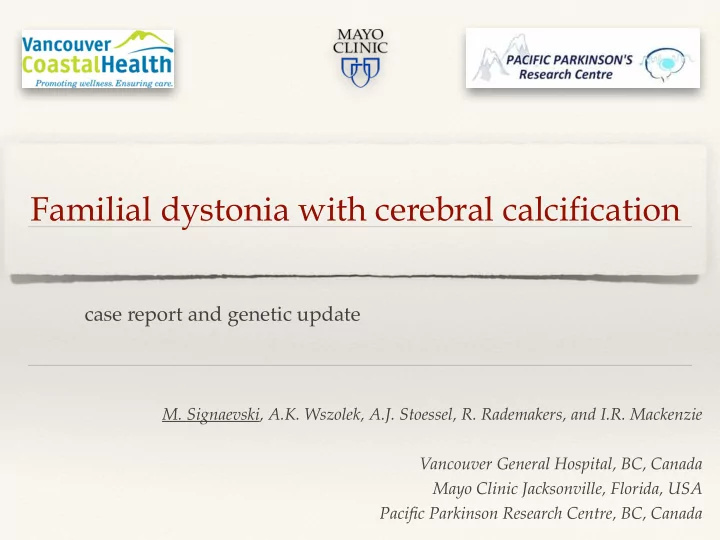

Familial dystonia with cerebral calcification case report and genetic update M. Signaevski, A.K. Wszolek, A.J. Stoessel, R. Rademakers, and I.R. Mackenzie Vancouver General Hospital, BC, Canada Mayo Clinic Jacksonville, Florida, USA Pacific Parkinson Research Centre, BC, Canada
nothing to disclose
Genealogy tree Canadian family with dystonia- plus syndrome and brain calcinosis: - followed since mid 80s - 6 generations - AD, highly penetrant Wszolek et al , Neurology, 2006;67:620–625
Family phenotype Symptoms - dystonia (oromandibular) +/- “plus” - dysarthria - chorea - ataxia - Parkinsonism - variable intellectual decline Cerebral calcifications : basal ganglia - thalamus - subcortical white matter - cerebellum -
11 symptomatic 8 asymptomatic Wszolek et al , Neurology, 2006;67:620–625
a i m l s g u u n m l M a l e g a W b l l a e a h r s e t a c b 11 symptomatic 8 asymptomatic Wszolek et al , Neurology, 2006;67:620–625
a i m l s g u u n m l M a l e g a W b l l a e a h r s e t a c b 11 symptomatic 8 - with dystonia all cases: range: 8-70 age at onset: mean ~19 dystonia+ cases range: 8-20 age of onset: mean ~ 13 Wszolek et al , Neurology, 2006;67:620–625
a i m l s g u u n m l M a l e g a W b l l a e a h r s e t a c b 11 symptomatic 8 asymptomatic Wszolek et al , Neurology, 2006;67:620–625
a i m l s g u u n m l M a l e g a W b l l a e a h r s e t a c b 8 asymptomatic still asymptomatic in mid life age range 45-57 mean =50 Wszolek et al , Neurology, 2006;67:620–625
Wszolek et al , Neurology, 2006;67:620–625
Genealogy tree III-9 Wszolek et al , Neurology, 2006;67:620–625
Clinical history 71 year old female with progressive movement disorder, dystonia, and intellectual decline age symptoms 10 - dysarthria and involuntary movements / oromabdibular 18 - right arm athetosis 28 - generalized involuntary movements - CT scan: bilateral symmetric calcifications: - basal ganglia, thalamus, and cerebellum 52 - subcortical white matter: occipital, temporal, parietal, frontal - frontal and parietal cortex - follow up CT scan - no change 67 - Ca, Cu, Phosphate, Fe - normal - generalized dystonia (predominantly upper body) - dysarthria, dysphagia ~ 51-71 - depression - repeated falls
CT scan, age 67
Gross pathology frontal WM lentiform
Gross pathology thalamus cerebellar dentate
Various parenchymal calcification patterns, H&E thalamus basal ganglia cerebellar dentate cerebellar WM & vessels
Cortical WM, H&E and von Kossa von Kossa
Vessel calcification patterns, H&E von Kossa
Pathology: striatum GFAP minor gliotic reaction to calcifications
Cerebellar vermis Cerebellar hemispheres Purkinje cells preserved Purkinje cell loss and Bergmann’s gliosis in calcified and in non-calcified areas
Pathology: IHC Hippocampus: alveus Hippocampus: CA1 ubiquitin ubiquitin Negative: - tau - alpha-synuclein - FUS - TDP-43
Genetic considerations: background Historically : Familial Idiopathic Basal Ganglia Calcification (IBGC, Fahr’s disease ): - movement abnormalities: dystonia, Parkinsonism, ataxia, chorea - may be asymptomatic To date : links to - Chr 14q (fIBGC1) - Chr 2q37 (fIBGC2) - Chr 8p21.1 (fIBGC3*: various mutations in SLC20A2 ) Mayo Clinic study (co-authors) : - mutation analysis of SLC20A2 in 27 cases of IBGC** - Mayo Clinic Jacksonville brain bank - including a member of Canadian IBGC family with dystonia-plus syndrome - brother of our case * Wang et al, Nature genetics, 2012, 4(3): 254-256 ** Baker et al, Neurogenetics, 2014 ,15(1): 23-30
III-3 (brother) 85M with ~60-year history of progressive movement disorder and dystonia-plus Pathology: - same pattern as III-9: - parenchymal - vascular Baker et al., Neurogenetics . 2014 March ; 15(1): 23–30.
Genetic analysis Mayo genetic study*: - cohort of 27 cases, histologically proven IBGC - two with SLC20A2 mutations were identified: - one - novel C338G nonsense mutation - another - deletion on chromosome 8p Copy number analysis: - deleted ~563Kb region on 8p11.21 in this member of the family Sequencing : - complete deletion of 7 genes: - VDAC3, SLC20A2 , c8ORF40, CHRNB3, CHRNA6, THAP1 , RNF170 - partially HOOK3 *Baker et al., Neurogenetics . 2014 March ; 15(1): 23–30.
SLC20A2 Gene : - SLC20A2 - chromosome 8p11.21 Protein : Sodium-dependent phosphate transporter 2 (PiT2) - homodimer - inorganic phosphate transport - pumps Phosphate into cell - ubiquitously expressed - highest in basal ganglia Mutations : loss-of-function - about 20 mutations in more than 40 families worldwide - truncated protein or loss of protein - explains 41% familial cases and 14% sporadic - excess of phosphate in the presence of Calcium => calcifications Disease : - idiopathic basal ganglia calcification - no dystonia phenotype is identified with isolated SLC20A2 loss.
THAP1 Gene : - THAP1 - chromosome 8p11.21 Protein : - THAP Domain Containing, Apoptosis Associated Protein 1 ( THanatos Associated Protein 1) - DNA-binding transcription factor - endothelial cell proliferation - G1/S cell-cycle progression. - possible pro-apoptotic activity via TNF-induced apoptosis. Mutations : loss-of-function: - Over 90 point mutations - autosomal dominant, penetrance of 40–60% Disease : - causes dystonia (DYT6) - one of the two genetically determined dystonias
~563Kb calcinosis dystonia
calcinosis dystonia ? +/- plus: dysarthria chorea ataxia Parkinsonism intellectual decline
calcinosis dystonia ? ? +/- plus: dysarthria chorea ataxia Parkinsonism intellectual decline
calcinosis dystonia ? ? +/- plus: dysarthria chorea ataxia Parkinsonism intellectual decline
calcinosis dystonia ? ? ? +/- plus: dysarthria chorea ataxia Parkinsonism intellectual decline
? calcinosis calcinosis dystonia ? +/- plus: dysarthria chorea ataxia Parkinsonism intellectual decline
Canadian family: - Cerebral Calcification +/- Dystonia-Plus syndrome - Autosomal Dominant - deletion on chromosome 8p11 - involving SLC20A2 and THAP1 genes Questions
Thank you
Recommend
More recommend